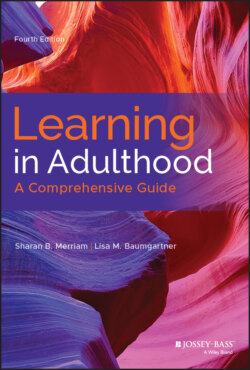Читать книгу Learning in Adulthood - Sharan B. Merriam - Страница 44
Johnstone and Rivera's Landmark Study
ОглавлениеIn 1962, an “inquiry into the nature of adult education in America” was funded by the Carnegie Corporation and carried out by researchers Johnstone and Rivera (1965) at the National Opinion Research Center (NORC) in Chicago. The study sought to describe participation in formal and informal educational activities, assess attitudes and opinions held by adults concerning education, describe the organizations delivering adult education in a typical urban community, and focus on the educational and work experiences of young adults ages 17–24. The findings of this first national study have provided a baseline against which the findings of subsequent studies have been compared.
Because comparisons are made, it is important to know how adult education and adult are defined in this study. Realizing the significance of this function, Johnstone and Rivera (1965, p. 26) struggled to come up with a definition of an adult educational activity that was broad enough to capture systematic efforts at learning but not so broad as to include “a host of activities… which would fall beyond the range of any reasonable or workable definition of adult education.” They decided that an adult education activity would have as its main purpose the desire to acquire some type of knowledge, information, or skill and that it would include some form of instruction (including self-instruction). They thus measured involvement as a full-time adult student, as a part-time participant in adult education activities, and as a participant in independent self-education. An adult was defined as anyone either age 21 or over, married, or the head of a household. Interviews with a random national sample of nearly 12,000 households formed the data set.
Using the preceding definitions, Johnstone and Rivera (1965) estimated that 22% of American adults participated in “one or more forms of learning” between June 1961 and June 1962 (p. 1). They also discovered that what adults were learning was largely practical and skill oriented rather than academic: “Subject matter directly useful in the performance of everyday tasks and obligations accounted for the most significant block of the total activities recorded. Together, the vocational and home and family life categories alone represented 44 percent of all formal courses studied and 47 percent of the subjects people studied on their own” (p. 3).
This groundbreaking study also identified the major demographic and socioeconomic characteristics of participants. Age and formal schooling were found to be the primary indicators of participation in adult education. Johnstone and Rivera's often-quoted profile of the typical adult learner has held up, with minor deviations, in all subsequent national studies of participation. Their profile is as follows: “The adult education participant is just as often a woman as a man, is typically under forty, has completed high school or more, enjoys an above-average income, works full-time and most often in a white-collar occupation, is married and has children, lives in an urbanized area but more likely in a suburb than large city, and is found in all parts of the country” (p. 8).
One of the strengths of Johnstone and Rivera's study is that they included “independent self-education” along with participation in formal courses and community-based activities. Unfortunately, as reviewed in the next section, the first nine national studies of participation were limited to organized instruction offered by educational institutions, business or industry, and community organizations.
